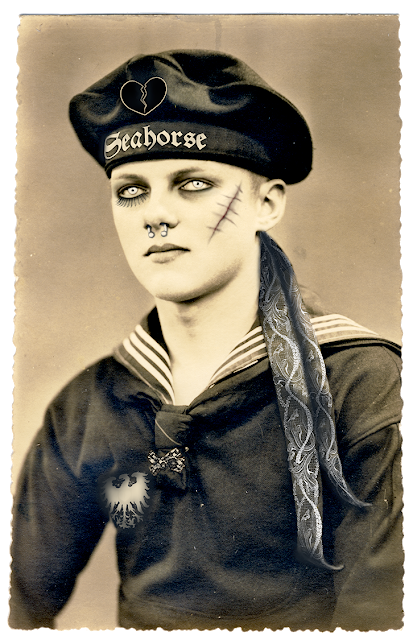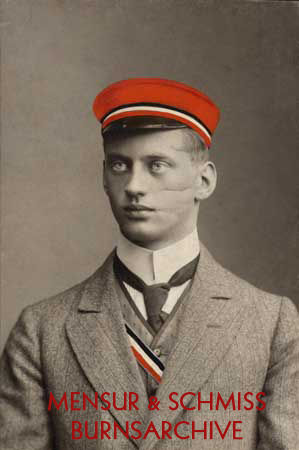


As it frequently tends to happen with my art-making process, I tap into ethereal realms, channeling ghosts and unseen energy, reaching out to the unconscious pulse in the universe and in the world.
The Kriegsmarine sailor above (Stuart Archive) came equipped with good bones, allowing the Goth transformation to easily take place. The final touch: his facial scar.
As it frequently tends to happen with my art-making process, I tap into ethereal realms, channeling ghosts and unseen energy, reaching out to the unconscious pulse in the universe and in the world. The creation process is usually not hindered by research and analysis. If research happens in tandem with the art-making process, the knowledge obtained from this pursuit always ignites an intentional path, so I never complain about the commingling. But when psychic energy leads the way, the messages always seem to synchronously align to my actual journey in life. The facial scar is one example of this. When I first added the scar to the The Knight of Swords Shadow Warrior tarot card, I did it out of a morbid fascination. Admittedly, I find facial scars sexy.
Mensurfechten: Fencing in a Confined Space
Many of the Goths in Blind Love during the Madness proudly display these dueling scars, which upon further research on the topic, and to my delight, I realized that the scars could be perceived as a mark of defiance...
I didn’t learn about academic fencing, or Mensur, as it is called in Germany (and in other parts in Europe) until a few months after I had completed the Knight of Swords. Mensur, which is short for word Mensurfechten, means fencing in a confined space. These duels are practiced by student corporations and between two males of different fraternities. In the old days, the goal was to acquire a disfiguring “Mensur scar.” Many of the Goths in Blind Love during the Madness proudly display these dueling scars, which upon further research on the topic, and to my delight, I realized that the scars could be perceived as a mark of defiance in Nazi Germany.
The Nazis officially banned academic fencing in 1933, forcing the duels to not only go underground, but to escalate. In 1940 alone, over 100 duels ensued in secret during this time period. The ban on academic fencing was eventually lifted in 1953 and the “sport” continues to this day.
The scars, which are called Schmisse, were considered aphrodisiacs. In fact, the more disfiguring the scar, the more attractive it was to the opposite sex. Nineteenth century German writer and journalist, Otto Bierbaum illustrates this point in his 1897 novel Stilpe: “My fiancée only wants me to have a good-looking schmiss,” asserts the protagonist, highlighting the allure and sexual power of the facial scar. Thus, the Mensur scar was regarded as a kind of status symbol that often carried the reward of success, financial security, and love.
Courage, Self-Confidence, and a Tribute to the Ancestors
Today, German statute stipulates that the goal of academic fencing is to promote self-confidence and courage while paying tribute to the ancestors. Although the Mensur scar is no longer valued as it once was, I can certainly understand the sex appeal from an archaic and Gothic standpoint.
Below are a few photos that I found online depicting the Mensur Schmisse. I’ve also included one of my own original photos of a hot German gentleman sporting his Mensur scar. I won this gem on Ebay years ago, long before I knew what a Mensur scar was.






My photo of the German gent with a schmiss (image above). There is writing on the back but it’s in Sütterlin script, so it’s difficult to decipher. I can make out the date
which reads November 20, 1926 (20 XI 26).

Other sources:
McAleer, K. (1994). Table of Contents. In Dueling: The Cult of Honor in Fin-de-Siecle Germany (pp. vii–viii). Princeton University Press. http://www.jstor.org/stable/j.ctt7ztmf7.2
The Cultivation of Hatred: The Bourgeois Experience: Victoria to Freud by Peter Gay Pg. 30
The German Student Corps in the Third Reich by R G Weber, pg. 168.

Comments